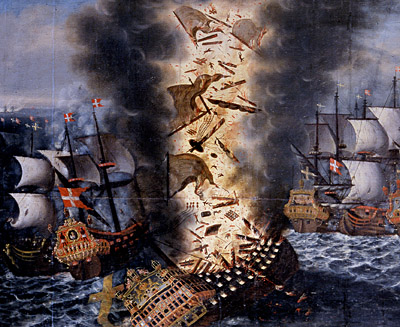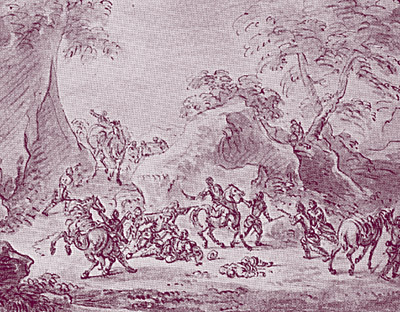| Skånske krig 1675-79

| | Den danske konge Christian 5. var besat af tanken om at erobre de tabte områder fra 1658 tilbage. Da den svenske hær kom i store vanskeligheder i Nordtyskland valgte han, trods advarsler fra sin rigskansler, at sætte en stor hær ind i Skåne sidst på sommeren i 1676.
Det begyndte godt med et stort søslag ved Øland, hvor svenskernes stolte flagskib Kronan eksploderede. Men Skånske krig, endte i en ny katastrofe for både Danmark og Skåne. |
Den såkaldte Skånske Krig var en dansk-norsk revanchekrig med det formål at tilbageerobre Skåne, som var tabt for Danmark under Karl Gustav-Krigene i 1657-60.
Stormagtsalliance
Efter Karl 10. Gustavs død i 1660 blev Sverige styret af en formynderregering med Magnus Gabriel De la Gardie i spidsen. Efter freden i København gik udenrigspolitikken ud på at undvige krig og bevogte den nye grænse mod Danmark. Det skulle ske ved en balancepolitik imellem Europas stormagtsblokke. Overfor stormagten Frankrig stod et forbund imellem Østrig, Holland, Spanien og Brandenburg. 1672 nærmede Sverige sig dog Frankrig og der blev indgået et forbund landene imellem.
Da den europæiske storkrig begyndte sluttede Danmark sig til Sveriges fjender og da det lykkedes Frankrig at få Sverige til at gå i krig mod Brandenburg havnende Danmark og Sverige definitivt på hver sin side i den europæiske storkonflikt. Efter at svenskerne havde lidt nederlag i Svensk Pommern gik danskerne til angreb mod Sverige, da man øjnede muligheden for revanche for det katastrofale nederlag i 1658.
Dansk angreb
Den hollandske og danske flåde besejrede de svenske ved Ølands sydspids i sommeren 1676. Det svenske slagskib Kronan, som da var Europas største orlogsfartøj, blev sænket.
Under den danske kong Christian V.s personlige befaling blev omkring 15.000 mand landsat i Råå syd for Helsingborg og straks derefter svor Helsingborgs borgere og bystyre troskab imod den danske konge. Man udså sig endvidere en dansk borgmester.

Den danske invasionsflåde 1676 | 
Søslaget ved Øland | 
Invasionsflåde på vej mod Råå | 
Helsingborgs erobring |
En blodig affære
Skånske Krig blev grum og blodig krig der, som navnet antyder, fortrinsvis foregik på skånsk jord. Danskerne drev de svenske tropper tilbage og fik kontrol over hele Skåne på nær Malmø. Store dele af den skånske befolkning tilsluttede sig danskerne. Voldsomme slag udkæmpedes ved Chrisansstad, Halmstad, Lund og Landskrona.
Slaget ved Lund var det blodigste som nogensinde er udkæmpet imellem Danmark og Sverige. De svenske tropper blev anført af den unge kong Karl XI. Slaget vendte krigen til svensk fordel og svenskerne kunne drive de danske tropper tilbage. Til slut holdt danskerne kun Landskrona og Helsingborg, men de blev tvunget til at indse at situationen var håbløs. Tusinder af flygtninge søgte over Øresund til Danmark.

Citadellet i Landskrona | 
Landskronas erobring | 
Landskronas erobring | 
Landskrona overgiver sig til Chr. 5. | 
Christianstads belejring 1676 |

Christianstads erobring | 
Slaget ved Lund 1677 | 
Slaget ved Lund 1677 | 
Slaget ved Lund 1677 | 
Slaget ved Lund 1677 |

Karl 11. | 
Slaget ved Malmø 1677 | 
Slaget ved Landskrona 1677 | 
Slaget ved Tirups Hed, Landskrona | 
Slaget i Køge bugt 1677 |
Stormagtsfred
Til søs havde den svenske flåde tabt, mens den danske hær til slut havde lidt nederlag på landjorden.
Man kan delvis påstå at krigen blev afgjort af Frankrig. Sveriges forbundsfælle Frankrig havde fået overtaget over Danmarks forbundsfælle Holland og sluttet fred, også på Sveriges vegne. Eftersom Holland havde gjort op med Frankrig stod Danmark alene i forhandlingerne og gik helt tomhændet ud af krigen ved fredsslutningen med Sverige i Lund 1679.
I Sverige var man ikke tilfredse med Frankrigs måde at varetage de svenske interesser på. Tilsvarende var danskerne også misfornøjede med hollændernes måd e at efterlade danskerne på i krigens slutfase. Dette førte til at Danmark og Sverige byttede allierede. Danmark gik i forbund med Frankrig og Sverige sluttede en venskabsaftale med Holland.
Forsoningsbryllup
Efter krigen skete der en politisk tilnærmelse mellem Sverige og Danmark, og der blev indgået et forbund som bekræftedes med giftermål imellem Karl 11. og den danske prinsesse Ulrika Eleonora. Under kanonsalut blev hun ført over Sundet og ankom til Helsingborg i maj måned 1680. I Helsingborg mødtes hun med Karl 11.s mor Hedvig Eleonora. Derefter rejste de kongelige igennem et af deres krig fordærvet og ødelagt landskab til bryllupsfest i Skottorp i det sydlige Halland, hvor præsten Haqvin Spegel ventede på ar forrette vielsen.

Den danske prinsesse Ulrika Eleonora |
| |
 | | Stor | Aria sopra le Nozze di Sua Maesta il Re de Svecia (1680) (Didrik Buxtehude) |
Snaphanerne

| | Den Skånske Krig blev en katastrofe for Skåne med omfattende ødelæggelser og tab af mange menneskeliv. Brutaliteten i krigsførelsen blev ikke mindre af, at krigen delvist blev ført som en partisankrig. Bl.a. af de såkaldte Snaphaner. |
Partisaner og friskytter
Den forfærdelige ødelæggelse som ramte Skåne i forbindelse med Skånske Krig blev ikke mindre af at krigen delvis førtes som partisankrig.Lokale bondeopbud, ofte med støtte af danskere, gennemførte baghold, kup og andre angreb mod svenskerne. Det lykkedes således et opbud af göingar at erobre den svenske krigskasse ved et kup i Loshult lige syd for grænsen til Småland. Samarbejde med smålandske bønder kan ikke udelukkes og værdien af det erobrede beløb sig til omkring 50.000 rigsdaler.
Selv såkaldte friskyttekorps med en rent militær organisation deltog i denne guerillakrig. Mange fattige bønder, men også soldater lod sig hverve som danske friskytter og indgik da som en del af den danske krigsorganisation. Sådanne grupper var virksomme over hele Skåne og der fandtes også fattige eventyrere og andre, deriblandt kriminelle, som nærmest førte deres egen krig i skovene i det nordlige Skåne på grænsen til Småland.

Skånske partisaner | 
Overfald | 
Snaphanekontrakt | 
Skåne 1677 | 
Skåne 1662 |
Begrebet Snaphane
Alle disse som indgik i bondeopbud, friskyttekompagnier og røverbander gik under betegnelsen ”Snaphaner”. Ordet kommer måske af det tyske ”schnappen”, som betyder at røve. I så fald indebar betegnelsen snaphane noget negativt og udtrykket skulle i så fald allerede fra starten have en vis negativ betydning, således at alle der fald indenfor betegnelsen skulle opfattes som røvere.
Grænseland og bondefred
Befolkningen i grænseområdet var, som altid i krig, særligt udsatte. Urgammelt samarbejde over grænsen modarbejdedes og at den svenske stat havde øget skatterne i disse områder skabte misfornøjelse. Bønder på begge sider som ikke tidligere havde brudt sig om nationale grænser sluttede såkaldt bondefred og demonstrerede dermed selvstændighed imod de nationale krav, som centralmagten førte frem. En sådan fred sluttedes f.eks. imellem Osby i Skåne og Virestad i Småland i 1676.
Undertiden benævnes Skånske Krig ligefrem Snaphanekrigen. Den eventyrlighed som præger partisankrig har givetvis næret fantasien, og de mange historier, ofte med romantiske og heroiske indslag, som eftertiden beretter om, skal nok tages med et gran salt. Snaphanerne og frem for alt deres lederes store betydning kan der dog ikke stilles spørgsmålstegn ved, hvilket reaktionerne på dem tydeligt viser.
Grusomme straffe
De hårde og grumme straffe somsnaphanerne idømtes, er bevis på at svenskerne blev alvorligt forstyrret af disse angreb, som forvoldte store skade for den svenske centraladministration og forsinkede uniformitetsarbejdet. Skånske bønder i nogle byer blev kollektivt afstraffet, fordi nogen af dem var blevet snaphaner. Der blev også vedtaget bestemmelser imod bønder som på en eller anden måde mistænktes for at pleje omgang med snaphanerne. Grumheder findes der masser af beretninger og vidnesbyrdom.
I foråret 1677 afkrævede svenskerne beboerne i Skåne loyalitetserklæringer og i april 1678 gav kongen befaling til at afbrænde alle gårde og dræbe alle våbenføre mænd i Ørkned Sogn i det nordøstlige Gønge Herred.

Sporekullagården | 
Gård fra 1600-tallet | 
Snaphanestatue |
Skånske flygtninge
I sommeren 1679, da Skånske Krig lakkede mod enden, opfordrede den danske konge igen skåningerne til at flygte til Sjælland og lokkede med tilsagn om 20 års skattefrihed. Hvor mange der tog imod dette tilbud er der delte meninger om, men 10.000 eller flere er nok ikke helt forkert og et ikke ubetydeligt antal efter datidens målestok. En del var flygtet allerede under krigen og flere kommer til ved soldaterudskrivningen i Skåne 1680. Erfaringerne viste at de unge skånske mænd blev deporteret til fjernliggende områder i Balticum og ofte ikke vendte tilbage igen.
De skåninger og andre der flygtede havnede fortrinsvis på Sjælland og Amager, hvor en del kunne overtage fæstegårde mens andre sikkert har fristet en mere kummerlig tilværelse og der var i lighed med den forrige krig også folk der vendte tilbage til Skåne igen. Forholdet imellem de landflygtige og fastboende har så vidt det kan skønnes været godt og en række danske byer, f.eks. København, Dragør og Helsingør fik ved den lejlighed et tiltrængt befolkningstilskud.
Bevægelsen dør ud
Samtidig med at mange blev skræmte af de hårde straffe, blev en del bønder trætte af de endeløse plyndringer og hærgninger der fandt sted, og et modsætningsforhold imellem snaphanerne og en del skånske bønder opstod. Dette førte til at snaphanernes antal sagte, men sikkert reduceredes og ved danskernes genkomst i sammenhæng med Store nordiske Krig i 1710, var snaphanebevægelsen uden større betydning.
Snaphanebevægelsens omfang, karakter og betydning diskuteres stadigvæk blandt historikere og lægmænd på begge sider af Øresund. |